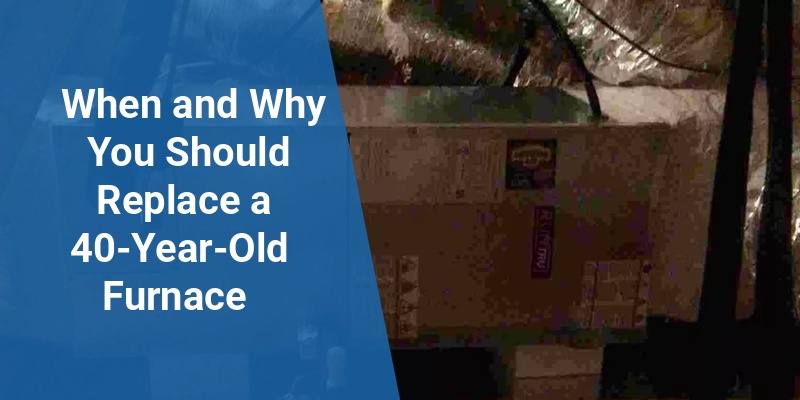Deciding whether to replace a 40-year-old furnace involves weighing several factors like efficiency, safety, repair costs, and comfort. Furnaces of this age typically operate far less efficiently than modern models, leading to higher energy bills. Additionally, older furnaces are more prone to breakdowns and may pose safety risks. This guide provides a detailed analysis of all important aspects to consider when determining if furnace replacement is the best option.
| Factor | Considerations for a 40-Year-Old Furnace | Replacement Benefits |
|---|---|---|
| Energy Efficiency | Low efficiency, often less than 60% AFUE | Modern furnaces exceed 90% AFUE, reducing energy bills |
| Safety | Possible gas leaks, cracked heat exchangers | New units meet current strict safety standards |
| Repair Costs | Frequent, costly repairs; parts scarce | Lower maintenance expenses, warranty coverage |
| Comfort | Uneven heating, poor airflow | Consistent warmth and better humidity control |
Signs That Indicate a Furnace Replacement Is Necessary
A 40-year-old furnace is beyond the typical life expectancy of most heating systems, which is around 15 to 25 years. Major warning signs include increasing utility bills, frequent repairs, inconsistent heating, unusual noises, and visible rust or cracks. A failing heat exchanger is particularly concerning as it can lead to dangerous carbon monoxide leaks. When any of these symptoms are present, it is wise to evaluate replacing the furnace.
Energy Efficiency and Cost Savings With a New Furnace
Older furnaces usually have an Annual Fuel Utilization Efficiency (AFUE) rating well below 70%, whereas modern high-efficiency models boast AFUE ratings of 90% or higher. Upgrading to a new furnace can reduce heating costs significantly, sometimes by 20-40% depending on the climate and usage. Over time, these savings often justify the initial investment in a new unit.
How Efficiency Impacts Your Monthly Bills
Low-efficiency furnaces convert less fuel into heat, wasting money and energy. New technology, such as variable-speed blowers and modulating burners, optimizes fuel consumption for steady warmth and lower bills. Homeowners can also benefit from rebates or tax credits offered for installing energy-efficient heating systems.
Safety Considerations With Aging Furnaces
Furnaces over 30 years old are more likely to develop cracks in their heat exchangers, which can leak carbon monoxide (CO), a colorless and odorless gas hazardous to health. Regular inspections become critical, but they may not catch every issue. Modern furnaces include enhanced safety features, such as sealed combustion chambers and CO detectors, that greatly reduce risks.
Cost Analysis: Repairs vs Replacement
As furnaces age, repair costs increase and parts become harder to find. Common repairs on old systems include replacing belts, motors, burners, and heat exchangers. When repair costs climb over 50% of the furnace replacement cost, it is financially smarter to replace rather than continually fix the unit.
| Item | Typical Cost for 40-Year-Old Furnace Repair | Approximate Replacement Cost |
|---|---|---|
| Heat Exchanger Replacement | $1,200 – $2,000 | $3,500 – $6,000 (new furnace) |
| Blower Motor Repair | $300 – $600 | Included in replacement cost |
| Full Furnace Replacement | Not applicable | $3,500 – $6,000 (depends on furnace type and home size) |
Improved Comfort and Advanced Features With New Furnaces
Modern furnaces offer advanced features like multi-stage heating and variable-speed blowers, which improve temperature consistency throughout the home and better manage indoor humidity levels. These comfort improvements can create a more pleasant indoor environment and reduce cold spots common with older systems.
Call 888-906-9139 for Free Local HVAC Quotes – No Obligation, Just Savings!
Integration With Smart Home Systems
Many new furnaces are compatible with smart thermostats and home automation systems, allowing homeowners to control temperature remotely and optimize energy usage. This technology also supports diagnostic alerts that help prevent costly repairs by identifying problems early.
Environmental Impact: Choosing a Cleaner Heating Option
Switching from an old furnace to a high-efficiency model reduces fuel consumption and greenhouse gas emissions. Some newer systems also support dual-fuel configurations, combining gas with electric heat pumps for even greater environmental benefits. Considering a replacement furnace is an opportunity to reduce your carbon footprint significantly.
How to Choose the Right Replacement Furnace
Selecting the ideal replacement involves considering stove type (gas, electric, or oil), size relative to home heating needs, AFUE rating, and additional features for comfort and efficiency. Consulting with HVAC professionals who perform load calculations ensures proper sizing and installation, maximizing performance and longevity.
Popular Furnace Types and Their Benefits
- Gas Furnaces: Most common, efficient, and provide powerful heating.
- Electric Furnaces: Ideal for homes without gas lines but generally more expensive to operate.
- Oil Furnaces: Less common, typically used in rural areas; require regular maintenance.
- Modulating Furnaces: Adjust heat output continuously for improved comfort and efficiency.
Financing and Incentives for Furnace Replacement
Many utility companies and government programs offer rebates or tax credits for installing ENERGY STAR certified furnaces. Financing options through HVAC providers can also make replacement affordable by spreading out costs. Exploring these opportunities makes upgrading your old furnace much more accessible.
Maintaining Your New Furnace for Longevity
After investing in a new furnace, regular maintenance extends its lifespan and sustains efficiency. Recommended practices include annual professional inspections, replacing air filters every 1-3 months, and keeping the unit clean. Proper upkeep prevents breakdowns and costly repairs.
